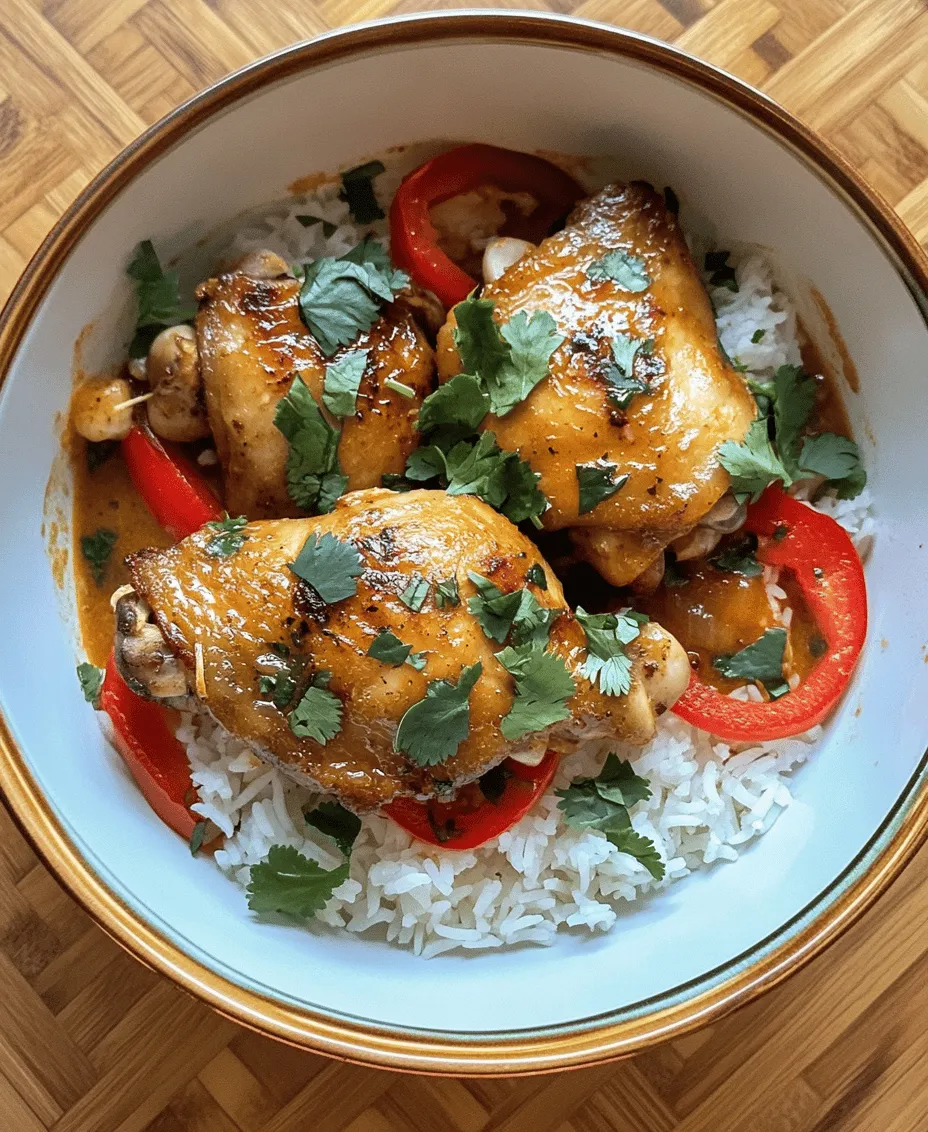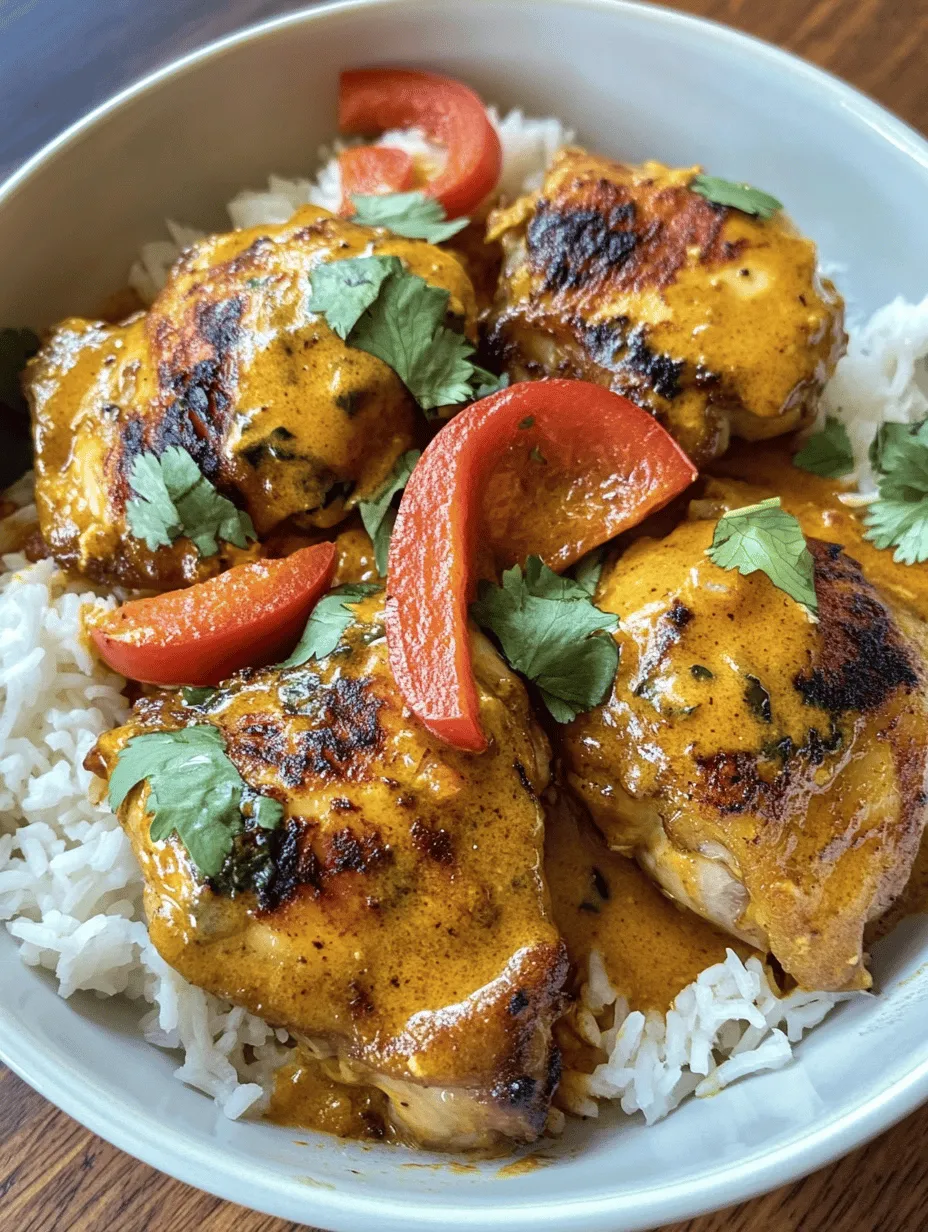Introduction
Brazilian cuisine is a colorful tapestry woven from diverse cultural influences, offering a spectacular array of flavors that reflect the country’s rich history. One of the most beloved dishes that capture the essence of this vibrant culinary landscape is Spicy Brazilian Coconut Chicken. This dish combines succulent chicken with the creamy richness of coconut milk and a medley of spices, creating a mouthwatering experience that transports your taste buds straight to the heart of Brazil.
Coconut milk is a staple ingredient in many traditional Brazilian recipes, particularly those hailing from the coastal regions where coconut palms thrive. Its ability to enhance flavors while providing a luscious texture makes it a perfect companion for chicken. The Spicy Brazilian Coconut Chicken recipe not only caters to spice lovers but also serves as a delightful introduction to the bold flavors of Brazilian fare. As we embark on this culinary journey, prepare to discover how easily this exotic dish can be recreated in your own kitchen, bringing a taste of Brazil to your dining table.
Exploring Brazilian Cuisine
Brazilian food is a melting pot of influences, shaped by its Indigenous roots, African heritage, and Portuguese colonization. Each of these cultures has contributed unique ingredients, techniques, and flavors that define Brazilian cuisine today. The result is a dynamic and diverse culinary landscape, characterized by hearty stews, vibrant side dishes, and an abundance of fresh ingredients.
Coconut milk plays a central role in many Brazilian dishes, particularly in the northeastern coastal regions where seafood and tropical fruits abound. It not only imparts a creamy texture but also serves as an excellent base for a variety of sauces and broths. In Spicy Brazilian Coconut Chicken, coconut milk melds beautifully with spices, creating a harmonious balance of heat and richness that elevates the dish to new heights.
The use of spices in Brazilian cooking is another hallmark of its culinary identity. Ingredients such as paprika, cayenne pepper, and cumin are often used to add depth and warmth, while fresh produce like onions, garlic, and bell peppers provide aromatic layers that enhance the overall flavor profile. This recipe exemplifies how these elements come together to create a dish that is not only satisfying but also a celebration of Brazil’s culinary heritage.
Ingredient Spotlight: The Key Components
To recreate the authentic flavors of Spicy Brazilian Coconut Chicken, it’s essential to understand the significance of each ingredient and how they contribute to the overall taste and texture of the dish.
– Chicken Thighs: The choice of chicken thighs, particularly bone-in and skin-on, is crucial for this recipe. Thighs are more flavorful and juicy than chicken breasts, and the skin helps to lock in moisture during cooking. The bones also add richness to the sauce, as they release flavor as they cook. This results in a tender chicken that absorbs the spices and coconut milk beautifully.
– Coconut Milk: Coconut milk is the star ingredient in this dish. Its creamy texture and natural sweetness balance the heat from the spices, creating a rich, velvety sauce that envelops the chicken. Beyond its delicious flavor, coconut milk is also packed with healthy fats and nutrients, making it a wholesome addition to your meal.
– Spices: The spices used in this recipe – paprika, cayenne pepper, and cumin – each play a pivotal role in developing the dish’s flavor profile. Paprika adds a mild sweetness and vibrant color, while cayenne pepper provides a kick of heat that can be adjusted according to your preference. Cumin contributes an earthy, warm flavor that rounds out the spice blend, creating a complex and satisfying depth.
– Fresh Ingredients: Fresh produce is essential for creating a well-rounded dish. Onions, garlic, and bell peppers are aromatic ingredients that enhance the flavor of the chicken and the sauce. Onions and garlic provide a savory foundation, while bell peppers add a hint of sweetness and crunch. Using fresh, high-quality ingredients is key to achieving an authentic and flavorful dish.
Marinating the Chicken
Marinating the chicken is a crucial step in ensuring that the flavors penetrate deeply into the meat, enhancing its taste and juiciness. The marinade for Spicy Brazilian Coconut Chicken is a blend of the spices mentioned earlier, along with coconut milk, which acts as both a flavor enhancer and a tenderizer.
Components of the Marinade
The marinade typically includes:
– Coconut milk: This creamy base not only imparts flavor but also helps to tenderize the chicken.
– Paprika, cayenne pepper, and cumin: These spices create a harmonious blend of heat and warmth, infusing the chicken with bold flavors.
– Fresh garlic and onion: These aromatics add depth, enhancing the overall taste of the dish.
Marinating Techniques
To properly marinate the chicken, follow these steps:
1. Combine the Ingredients: In a bowl, mix the coconut milk with the spices, minced garlic, and chopped onions until well combined.
2. Prepare the Chicken: Place the chicken thighs in a large resealable plastic bag or a shallow dish.
3. Add the Marinade: Pour the marinade over the chicken, ensuring each piece is generously coated. Seal the bag or cover the dish with plastic wrap.
4. Refrigerate: For optimal flavor absorption, marinate the chicken in the refrigerator for at least 1 hour, but ideally for 4-8 hours or overnight if time permits. This allows the flavors to infuse deeply into the meat.
By following these marinating techniques, you can ensure that your Spicy Brazilian Coconut Chicken is bursting with flavor and tenderness, ready to be cooked to perfection. The next steps will guide you through the cooking process, enabling you to create a dish that is not only delicious but also a true reflection of Brazilian culinary artistry.

Cooking Techniques and Methods
Preparing Spicy Brazilian Coconut Chicken involves a combination of cooking techniques that contribute to the dish’s rich flavors and textures. The process is straightforward but requires attention to detail to ensure the chicken is cooked perfectly.
Searing
The first step in preparing this dish is searing the chicken. This technique involves cooking the chicken skin-side down in a hot pan with a bit of oil. The benefits of searing include:
– Flavor Development: Searing creates a flavorful crust due to the Maillard reaction, which enhances the overall taste of the dish.
– Texture: The crispy skin adds a delightful texture contrast to the tender meat inside, making each bite enjoyable.
– Moisture Retention: By sealing the chicken quickly, you help retain moisture, which is crucial for keeping the meat juicy during the cooking process.
To achieve the best sear, ensure your pan is preheated and the oil is shimmering before placing the chicken in it. Avoid overcrowding the pan; cook in batches if necessary to maintain high heat.
Simmering and Baking
After searing, the next steps involve simmering the chicken in a flavorful coconut sauce and then baking it to finish cooking. Here’s how these techniques work together:
– Simmering: Once the chicken is seared, remove it from the pan and set it aside. In the same pan, you will add the coconut milk, spices, and other ingredients to create a sauce. Return the chicken to the pan, cover it, and let it simmer. This method allows the chicken to absorb the flavors of the sauce while cooking through.
– Baking: After simmering, transferring the chicken to the oven allows for even cooking and helps meld all the flavors together. Baking ensures that the chicken reaches the right internal temperature without drying out.
Importance of Internal Temperature
When cooking poultry, it’s crucial to ensure that it reaches a safe internal temperature. The USDA recommends that chicken be cooked to an internal temperature of 165°F (75°C). To check this:
– Use a meat thermometer inserted into the thickest part of the chicken, avoiding the bone.
– If the temperature reads 165°F, the chicken is safe to eat. If not, return it to the oven or pan until it reaches the appropriate temperature.
Serving Suggestions
Once your Spicy Brazilian Coconut Chicken is cooked to perfection, it’s time to think about how to serve it. Pairing the dish with complementary sides can elevate the meal and enhance the dining experience.
Rice Variations
Rice is a traditional accompaniment to many Brazilian dishes, especially those featuring rich sauces. Here are some rice variations that pair beautifully with your coconut chicken:
– Jasmine Rice: This fragrant rice has a subtle sweetness that complements the spicy and creamy coconut sauce beautifully.
– Basmati Rice: With its nutty flavor and fluffy texture, basmati rice provides a lovely contrast to the richness of the chicken.
– Coconut Rice: For a more tropical twist, consider making coconut rice by cooking jasmine or basmati rice in coconut milk instead of water. This will further enhance the coconut flavor in your dish.
Garnish Options
Garnishes can make your dish more visually appealing and add fresh flavors. Here are some suggestions:
– Lime Wedges: Adding a squeeze of lime juice just before serving brightens the dish and cuts through the richness of the coconut milk.
– Fresh Herbs: Chopped cilantro or parsley can add a pop of color and freshness. Sprinkle them on top just before serving to enhance the presentation.
– Avocado Slices: Creamy avocado can add another layer of flavor and texture. Serve slices on the side or on top of the chicken for a beautiful finish.
Cultural Significance and Variations
Spicy Brazilian Coconut Chicken is not just a meal; it embodies the rich culinary traditions of Brazil. The dish reflects the country’s diverse influences, including Indigenous, African, and Portuguese cuisines.
Regional Variations
Within Brazil, different regions have their unique takes on coconut chicken, often incorporating local ingredients:
– Northeast Brazil: In this region, you might find recipes that include dendê oil (palm oil) for an extra layer of flavor and a vibrant color.
– Amazonian Influence: Here, local ingredients like açaí or even jambu (a native herb) might be used to create variations that reflect the biodiversity of the Amazon rainforest.
– Coastal Regions: Coastal areas may use fresh seafood alongside chicken, combining the two proteins in a delicious fusion dish.
Dietary Adaptations
This recipe is versatile and can be adapted to meet various dietary needs:
– Gluten-Free: The recipe is naturally gluten-free. Just ensure all your ingredients, especially sauces, are certified gluten-free.
– Dairy-Free: Since the recipe uses coconut milk, it is dairy-free. It’s a perfect option for those with lactose intolerance.
– Low-Carb: For a low-carb option, serve the chicken with cauliflower rice or steamed vegetables instead of traditional rice.
Conclusion
Spicy Brazilian Coconut Chicken is a delightful dish that brings together the vibrant flavors of Brazil in a simple yet elegant way. Through techniques like searing, simmering, and baking, you create a meal that is not only flavorful but also visually appealing. The dish’s rich history and regional variations reflect the diverse culinary landscape of Brazil, making it a wonderful exploration into the country’s culture.
As you embrace the experience of cooking this dish, remember that food has a unique power to bring people together. Share this wonderful meal with family and friends, creating lasting memories around the dinner table. Whether it’s a casual weeknight dinner or a festive gathering, Spicy Brazilian Coconut Chicken is sure to impress. Enjoy the process, the flavors, and the joy of sharing good food with those you love.



